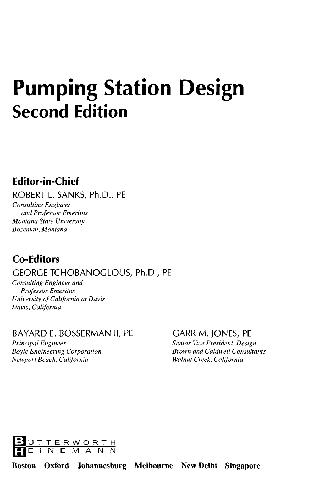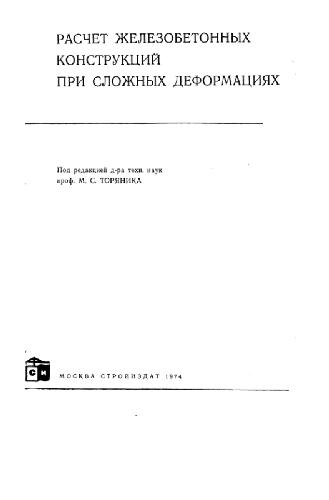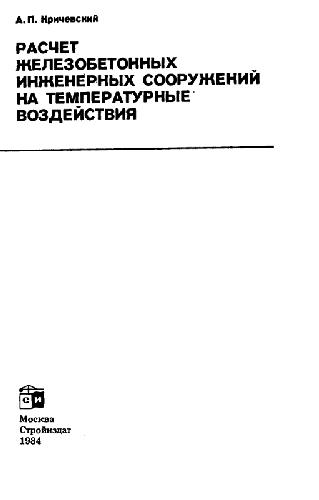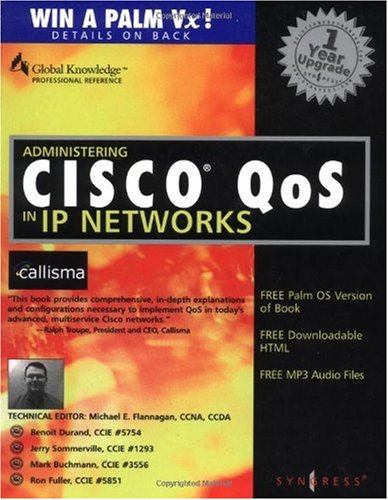Sanks R.L.1-7506-9483-1
Table of contents :
Contents……Page 4
List of Examples……Page 18
Locator for Equations, Figures and Tables……Page 20
Preface to the Second Edition……Page 24
Acknowledgements……Page 25
Preface to the First Edition……Page 26
Authors and Contributors……Page 28
1-2 Responsibilities of Project Engineers……Page 35
1-5 Manufacturer’s Recommendations……Page 36
1-7 How to Utilize This Book……Page 37
1-8 How to Select Consulting Engineering Firms……Page 38
1-9 Value Engineering……Page 39
1-10 Ensuring Quality and Economy……Page 40
1-11 Avoiding Litigation……Page 41
1-13 Operator Training……Page 42
1-14 References……Page 43
2-1 Abbreviations……Page 44
2-2 Definitions……Page 50
2-4 Supplementary Reading……Page 56
3-1 Fundamentals of Hydraulics……Page 66
3-2 Friction Losses in Pipe……Page 68
3-3 Pipe Tables……Page 73
3-5 Friction Losses in Open Channel Flow……Page 76
3-6 Energy in Pressurized Pipe Flow……Page 78
3-7 Energy in Open Channel Flow……Page 80
3-8 Unbalanced Hydraulic Forces……Page 84
3-9 Field Measurement of Friction Coefficient……Page 86
3-11 Unsteady Flow……Page 95
3-12 Model Studies……Page 96
3-14 References……Page 99
4. Piping……Page 101
4-1 Selection of Exposed Pipe……Page 102
4-2 Selection of Buried Piping……Page 110
4-3 Ductile Iron Pipe (DIP)……Page 116
4-5 Plastic Pipe……Page 120
4-7 Reinforced Concrete Pressure Pipe (RCPP)……Page 122
4-8 Design of Piping……Page 123
4-9 Special Piping and Plumbing……Page 134
4-10 References……Page 137
4-11 Supplementary Reading……Page 138
5-1 Designing for Quality……Page 139
5-2 Isolation Valves……Page 142
5-3 Sluice Gates, Shear Gates, Flap Valves, and Stop Plates……Page 151
5-4 Check Valves……Page 153
5-5 Control Valves……Page 158
5-6 Valve Actuators……Page 162
5-7 Air and Vacuum Valves……Page 164
5-8 aterials of Construction……Page 166
5-9 Installation of Valves……Page 167
5-11 References……Page 168
6-1 Introduction……Page 170
6-3 Methods of Analysis……Page 171
6-4 Surge Concepts in Frictionless Flow……Page 172
6-5 Slow Closure of Valves……Page 176
6-6 Surge Concepts in Flow with Friction……Page 179
6-7 Column Separation……Page 180
6-8 Criteria for Conducting Transient Analysis……Page 181
6-9 References……Page 182
7-1 Overview of Hydraulic Transient Control Strategies……Page 183
7-2 Control of Pumps……Page 190
7-3 Control Tanks……Page 191
7-4 Valves for Transient Control……Page 192
7-6 Surge Control for Water Pumping Stations……Page 194
7-7 Surge Control for Raw Sewage Pumping Stations……Page 199
7-8 Pipeline Design……Page 200
7-9 Computer Analysis……Page 202
7-10 Transients in Distribution Systems……Page 206
7-11 References……Page 207
8-1 Definitions and Code References……Page 208
8-2 Electrical Fundamentals……Page 209
8-3 Power and Control System Elements……Page 216
8-4 Standby Generators and Auxiliaries……Page 232
8-5 Grounding……Page 234
8-6 Lighting and Power Outlets……Page 237
8-7 Electrical Circuit Diagrams……Page 240
8-8 Power and Control System Practices……Page 243
8-10 Supplementary Reading……Page 246
9-1 Final Construction Drawings……Page 247
9-2 Specifications……Page 249
9-3 Contacting Utilities……Page 250
9-5 Load Estimation……Page 251
9-6 Overcurrent Protection and Conductor Sizing……Page 254
9-7 Lighting……Page 260
9-8 Power Factor……Page 262
9-9 Engine-Generator Sizing……Page 263
9-10 Short Circuit Current Calculations……Page 265
9-12 Construction Service……Page 267
9-13 References……Page 268
10-2 Pump Application Terminology, Equations, and Performance Curves……Page 269
10-3 Pump Operating Characteristics……Page 276
10-4 Cavitation……Page 283
10-5 Pump Characteristic Curves……Page 290
10-6 Pump Operating Ranges……Page 293
10-7 Elementary Pump System Analysis……Page 294
10-8 Practical Pumping System H-Q Curve Analysis……Page 299
10-10 References……Page 304
11-1 General Classifications of Pumps……Page 305
11-2 Classification of Centrifugal Pumps……Page 310
11-3 Construction of Centrifugal Pumps……Page 311
11-4 Overhung-Impeller Pumps……Page 320
11-5 Impeller-between-Bearings Pumps……Page 328
11-6 Classification of Vertical Pumps……Page 329
11-7 Construction of Vertical Pumps……Page 330
11-8 Types of Vertical Pumps……Page 335
11-9 Positive-Displacement Pumps……Page 337
11-10 Special Pumps……Page 340
11-11 Summary of Typical Pump Applications……Page 342
11-13 Supplementary Reading……Page 343
12-1 Initial Screening……Page 344
12-2 Final Selection……Page 347
12-3 Illustrative Examples……Page 348
12-4 Summary and General Considerations in Pump Selection……Page 364
12-5 Installation……Page 367
12-6 Pump Intake Basins: An Appraisal……Page 377
12-7 Pump Intake Basin Design……Page 383
12-8 References……Page 426
13-1 General……Page 428
13-2 Applications of Motors……Page 430
13-3 Fundamentals……Page 432
13-4 Types of Motors for Pump Drivers……Page 434
13-6 Motor Speed……Page 437
13-7 Motor Voltage……Page 438
13-8 Enclosures……Page 439
13-9 Insulation……Page 440
13-10 Service Factors for Squirrel-Cage Motors……Page 441
13-11 Motor Starting Frequency……Page 444
13-12 Micellaneous Motor Features……Page 445
13-13 Specifying Pumping Unit Drivers……Page 447
13-15 Design Checklist……Page 448
13-16 References……Page 449
14-1 Selecting and Engine Drive……Page 450
14-2 Duty Cycle……Page 451
14-3 Fuel for Engines……Page 452
14-6 Application Criteria……Page 455
14-9 Controls……Page 457
14-11 Accessories for Engines……Page 458
14-12 Combustion Air……Page 459
14-14 Pollution Control……Page 462
14-15 Vibration Isolation……Page 463
14-19 Service Piping……Page 464
14-20 Building Envelope……Page 465
14-22 Maintenance……Page 466
15. Variable-Speed Pumping……Page 469
15-1 Variable Speed versus Constant Speed……Page 470
15-2 Design Considerations……Page 471
15-3 Theory of Variable-Speed Pumping……Page 472
15-4 Pump Selection……Page 476
15-5 Variable- and Constant-Speed Pumps in Simultaneous Operation……Page 480
15-6 Special Design Considerations……Page 483
15-7 Analysis of Variable-Speed Booster Pumping……Page 484
15-8 Minimum Discharge Rate……Page 488
15-9 Operations in Booster Pumping……Page 491
15-10 Simultaneous Operation of V/S and C/S Booster Pumps……Page 492
5-11 Adjustable- and Variable-Speed Drives……Page 493
5-12 References……Page 509
16-1 Comparison of Two Approaches to Writing Specifications……Page 510
16-3 Nonrestrictive Specifications……Page 511
16-4 Operating Conditions……Page 512
16-6 Pump Testing……Page 513
16-10 Seals……Page 517
16-15 Optimum Efficiency……Page 518
16-16 References……Page 519
17-1 Organization and Control of the Process……Page 520
17-2 Preliminary Engineering……Page 521
17-3 Detailed Layout……Page 524
17-4 Detailed Design……Page 528
17-5 Examples of Large Lift Stations……Page 529
17-6 Examples of Medium-Size Lift Stations……Page 539
17-7 Examples of Small Lift Stations……Page 547
17-8 References……Page 553
18-2 Pumping Station Flow and Pressure Requirements……Page 554
18-3 Raw Water Pumping from Rivers and Lakes……Page 558
18-4 Raw Water Pumping from Aqueducts……Page 569
18-5 Well Pumps with Elevated Tanks……Page 576
18-6 Booster Pumping Stations……Page 585
18-8 Suggested Reading……Page 596
19. System Design for Sludge Pumping……Page 597
19-1 Hydraulic Design……Page 598
19-2 Types of Pumps……Page 605
19-3 Pumping System Design……Page 609
19-4 Piping System Design……Page 619
19-6 References……Page 623
20-1 Reliability……Page 625
20-2 Instrument Selection……Page 626
20-3 Level Measurements……Page 629
20-4 Pressure Meassurements……Page 634
20-5 Flow Measurements in Pipes……Page 636
20-6 Open Channel Flow Measurement……Page 642
20-7 Cholorine Residual Measurement……Page 643
20-8 Utility and Environmental Measurements……Page 644
20-9 Pumping Unit Monitors……Page 646
20-10 Control Equipment……Page 647
20-11 Control Logic……Page 648
20-12 Altitude Valves……Page 649
20-13 Monitoring and Data Acquisition……Page 650
20-14 Design Considerations……Page 651
20-16 Supplementary Reading……Page 652
21-1 Process and Insturmentation Diagrams……Page 653
21-2 Well Pump with Hydropneumatic Tank……Page 654
21-3 Booster Stations……Page 655
21-4 High-Service Pumping Station……Page 656
21-5 Small Wastewater Lift Station……Page 657
21-6 Moderately Sized Lift Station……Page 659
21-7 Large Wastewater Pumping Station……Page 660
22-1 Problems of Vibration and Noise……Page 664
22-2 Avoiding Vibration Problems……Page 666
22-3 Troubleshooting Excessive Vibration……Page 673
22-4 Introduction to Vibration and Noise Calculations……Page 682
22-5 Vibration and Noise Characteristics……Page 685
22-6 Applicable Codes……Page 688
22-8 Vibration Isolation Theory……Page 692
22-9 Vibration Isolators……Page 695
22-10 Piping Vibration……Page 698
22-11 Vibration of Drive Shafts……Page 708
22-12 Vibration of Structures……Page 712
22-13 Noise……Page 714
22-14 Reducing Exterior Nosie……Page 724
22-15 References……Page 726
23-1 Need for Heating, Ventilating, and Air Conditioning……Page 728
23-2 HVAC Design Criteria……Page 731
23-3 Order Control……Page 733
23-4 Dry Well Design Guidelines……Page 737
23-7 Sequence of Design Steps……Page 741
23-8 Ventilating System Design……Page 743
23-9 Design of Heating Systems……Page 751
23-10 Design of Building Cooling Systems……Page 755
23-11 Design of Refrigerated Cooling Systems……Page 757
23-23 Supplementary Reading……Page 760
24-2 Landscaping……Page 761
24-3 Hydraulics……Page 762
24-4 Mechanical Considerations……Page 763
24-5 Electrical Considerations……Page 764
24-8 Specifications……Page 765
24-9 Operators’ Preferences……Page 766
24-10 Survey of Two Thousand Wastewater Pumping Sations……Page 774
24-11 References……Page 782
25. Summary of Design Considerations……Page 783
25-1 Need for Pumping Stations……Page 784
25-2 Site Selection……Page 785
25-3 Architectural and Environmental Considerations……Page 787
25-4 Future Expansion……Page 791
25-5 Hydraulic Constraints……Page 792
25-6 Types of Pumping Stations……Page 793
25-7 Power, Drivers, and Standby……Page 804
25-8 Station Auxiliaries……Page 810
25-9 Instruments and Control……Page 813
25-10 Structural Design……Page 814
25-11 Concrete Protection: Coatings and Linings……Page 822
25-12 Force Main Design……Page 823
25-13 References……Page 824
26. Pumping Station Design Examples……Page 825
26-1 Redesigned Clyde Wastewater Pumping Station……Page 826
26-2 Redesigned Kirkland Wastewater Pumping Station……Page 832
26-3 Jameson Canyon Raw Water Pumping Station……Page 838
26-4 Albany Combined Sewer Overflow Pumping Station (CSO PS 88)……Page 841
26-5 References……Page 845
27-1 General……Page 849
27-4 Safety……Page 850
27-5 Hydraulics……Page 851
27-6 Pumps……Page 852
27-7 Valves……Page 855
27-8 Mechanical……Page 857
27-9 Electrical……Page 858
27-11 Specifications……Page 859
27-15 Design Reviews……Page 860
27-17 References……Page 862
28-1 General……Page 863
28-2 Contractual or Legal Documents……Page 864
28-3 Technical Specifications……Page 866
28-4 Source Material……Page 867
28-5 Specifying Quality……Page 869
28-7 References……Page 870
29-1 Cost Index……Page 872
29-2 Cost Curves……Page 874
29-3 Maintenance and Energy……Page 878
29-4 Interest Formulas……Page 881
29-5 Cost Estimates……Page 883
29-6 References……Page 898
Appendix A: Physical Data……Page 900
Appendix B: Data for Flow in Pipes, Fittings, and Valves……Page 909
Appendix C: Typical Specifications for Pumps and Drivers……Page 926
Appendix D: Common Blunders……Page 939
Appendix E: Codes, Specifications, and Standards……Page 941
Appendix F: Publishers……Page 949
Appendix G: Checklist for Project Reviews……Page 955
Appendix H: Start-Up……Page 961
Appendix I: Addenda……Page 979
Index……Page 982







Reviews
There are no reviews yet.